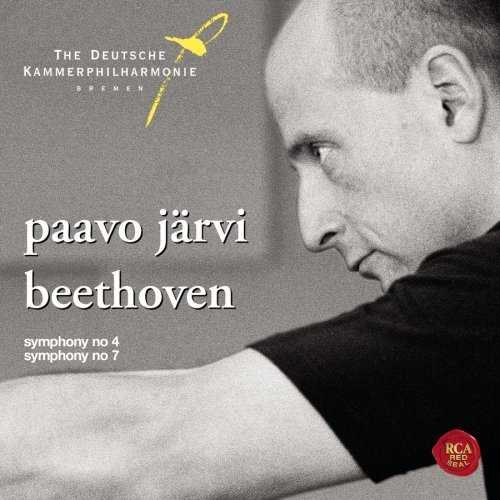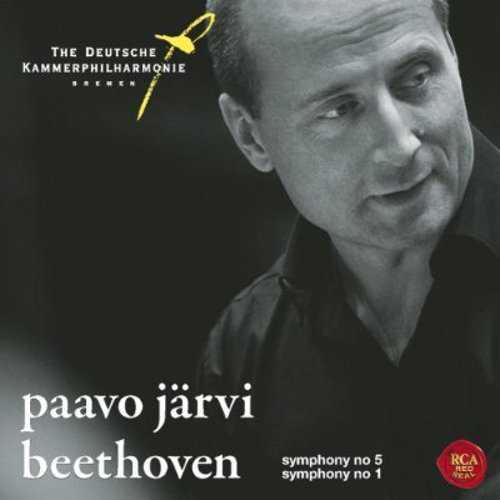
Composer: Ludwig van Beethoven
Orchestra: The Deutsche Kammerphilharmonie
Conductor: Paavo Jarvi
Audio CD
Number of Discs: 1
Format: FLAC (image+cue)
Label: RCA
Size: 287 MB
Recovery: +3%
Scan: no
Symphony No. 4
A. Adagio – Allegro vivace
Two. Adagio
Three. Menuetto – Trio. Allegro vivace – Un poco meno allegro
4. Allegro ma non troppo
Symphony No. 7
A. Poco sostenuto – Vivace
Two. Allegretto
Three. Presto – Assai meno presto
4. Allegro con brio
Bravo – modern reference Fourth and fantastic Seventh
This is such an exciting time for Beethoven. Since the publication of the new Barenreiter editions, edited by Jonathan Del Mar, we’ve seen cycles from the likes of Claudio Abbado (twice), Bernard Haitink, Simon Rattle, David Zinman, and Jos van Immerseel. But the most stellar cycle came from a rather unexpected source; Osmo Vanska with the Minnesota Orchestra for the Swedish label BIS. Vanska’s now-complete cycle has received raved reviews, and rightfully so. Vanska and his band have proved that “big band” Beethoven is still viable in the wake of the Period Movement and when Historically Informed Performance practices are en vogue. So it is into this glutted market that Paavo Jarvi and the Deutsche Kammerphilharmonie Bremen launch their cycle, beginning with the standard paring of the Eroica and the Eighth. So the question to be asked and answered is whether Jarvi has produced performances that can stand up to the competition?
The answer is a resounding, enthusiastic yes. This is, bar none, exceptional top-tier Beethoven. Right from the opening chord of the Fourth, you know these performances are going to be winners. First, and foremost, Jarvi brings an idiomatic and individualist interpretation that highlights interesting aspects of the score while maintaining a strong sense of architecture and form. Add to this brisk, but never rushed, tempos that imbue the music with a new sense of urgency. Finally, add to this winning mix one of the greatest chamber orchestras at work today, stereophonically placed violins, hard mallets for the timpani, pert woodwinds, and big-bodied brass, you have Beethoven for the ages.
This is a spectacular Fouth, one of the most thoroughly logical interpretations to come about in a long time. The slow introduction showcases the precision of Jarvi’s Bremen players, to say nothing of the multiplicity of colors elicited from the Kammerphilharmonie. But Jarvi work from the podium is really special. Listen to how the two chords before the allegro proper actually sound appropriately connected to the introduction. Jarvi’s work in the exposition is simply stunning. In the large tutti outburst before the second subject, where the violins are building on the main theme, Jarvi has the brass, winds, timpani, and lower strings really proclaim their rhythmic punctuations. Of course, this adds a great deal of tension, but it also shows Jarvi’s understanding of Beethoven’s writing and his ability to realize the composer’s intentions in new and provocative ways. The development is equally fine, complete with a full-bodied, but never grotesque, dissonant pile-up, and a wonderfully fun transition into the recapitulation. The recapitulation is equally exciting because Jarvi revels in the changes in orchestration, allowing the music to take on a wholly new and more visceral quality.
The two middle movements are lovely and energetic respectively. The adagio is a joy due to Jarvi’s crisp rhythms and brisk, but never rushed, tempo, aided by the atmospheric playing of the orchestra. What a shock the bumptious scherzo (in everything by name) is then, taken at a reasonable clip, tripping along self-consciously. The various syncopations and rhythmic shifts are emphasized with a stunning degree of success, while Jarvi shapes the music (both here and in the trio) effectively. Listen to how the final bars of the trio are more effective when the orchestra is not playing at one huge dynamic throughout.
The finale is equally fine, due to Jarvi’s basic musicality. Jarvi allows the orchestra to play out in their dissonant outbursts, but never at the expense of textual clarity. As such, the first violins register with acute clarity. In the coda, Jarvi pulls the orchestra back right before the slow music in order to unearth the long-buried bass line. These seem like basic and obvious interpretive choices, but Jarvi is one of the few conductors to have such idiomatic, but musically appropriate, ideas in this music.
Or course, the playing of the Bremen Kammerphilharmoic cannot be more highly praised. Just listen to the fabulous horns in the slow introduction, creating some really deep and satisfying pedal tones. The clarinet work throughout is excellent and the brass is always exciting. And the string work is perfect. The Fourth, probably more so than any other Beethoven symphony, really benefits from stereophonically placed violins. And here, all the interchanges and exchanges between the violins are captured with refreshing clarity, chocked full of good humor.
The Seventh is hardly less fine, if only because Jarvi makes one interpretive decision which, while well reasoned, robs the music of some of its intrinsic vigor. In the allegro, Jarvi purposefully keeps the high horns in check. This does prevent the music from sounding like a concerto for horns and strings (as it often can, and does, sound with in other performances) but one cannot help but miss their whooping declamations. The middle movements, however, are fabulous. I absolutely love that Jarvi has the second movement, here taken at a real allegretto, flow right out of the first. This makes sense, not only because the movements compliment each other so perfectly, but also because Beethoven ends the first movement in such a way as to expect another chord. Thus, the sudden minor interjection is especially thrilling. Playing-wise, the ensemble work is stunning and Jarvi shapes the music with embarrassing effectiveness. The presto is good fun as well, Jarvi handling the always-problematic trio well, rightfully emphasizing, rather than covering-up (cue nearly every other conductor) the somewhat awkward syncopated rhythms before the huge tutti outbursts.
Sevenths can be made or broken by their finales, and here Jarvi really just delivers a winner. It is just all energy and you realize that this music is simply too cosmic, too powerful to be played by any orchestra effectively. The orchestra always seems on the edge of just exploding, which in this music is high praise. The antiphonal violins add textual clarity, especially when the Beethoven sends the second violins to the races with their swirling figures. A touch more horn would be nice, especially in the coda, but the music builds to such a satisfying and frightening close, that you would hardly notice otherwise.
Jarvi’s Beethoven has all the ensemble precision of Szell or Vanska and the excitement of Wand or Toscanini. If to some listeners his approach sounds vulgar or “too big,” most will appreciate that Jarvi’s approach – small players, stereophonically placed violins, hard mallets for the timpani, and quick tempos – are exactly what Beethoven’s music requires. I once heard a critic remark that Beethoven’s music was “too big” for his orchestrations, that the bigness of the Eroica or the Fifth cannot be matched by any orchestra. I am reminded of that when listening to Jarvi’s Beethoven. His energy, his passion, not to mention his innate musicality, create performances that sound ready to burst at the seems with untamed musical fervor. I just love this cycle, a love that has not dimmed since the opening chords of his brilliant Eroica. Bravo.




many thanks